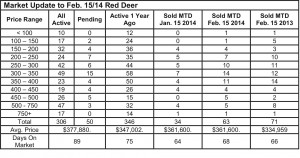February 15, 2014 – Market Update
Sales in the first half of February are up from the same period last month, but down slightly from 2013. The number of active listings is down from last year, but up slightly from January of this year. At the pace sales are on this month, the market will continue to be firmly in favour of sellers and prices will continue to rise. People considering a purchase this year would be well advised to start the process quickly to take advantage of the best prices they are likely to see this year as well as very favorable interest rates.
The central Alberta economy will continue to grow in 2014 as energy prices strengthen, construction on the NOVA plant addition ramps up, and optimism for US approval of the Keystone Pipeline increases. If Red Deer gets approval this fall to host the 2019 winter games, it will trigger a host of new investments that will also ramp up the central Alberta economy. That economic growth will result in population growth and stronger demand for rental accommodations and housing and potentially higher prices unless we see an incredible surge in new home construction.
The Source of so Many Newcomers, Todd Hirsch, Chief Economist, ATB Financial
The stampede of job seekers to Alberta from other provinces reached a record high in 2013. We often assume Newfoundland and Labrador and Saskatchewan are where we get most of our new arrivals, but for most of the last twenty years, Ontario has been the largest source of migrants moving to Alberta.
In 2012-13, 36,680 people came from Ontario—about a third of total migration from all provinces combined. Since 1992, the central province has accounted for, on average, 24 per cent of interprovincial migration to Alberta. The figures count in-migration only. Each year some Albertans move to other provinces (which would leave the net-migration figure somewhat lower). The fact that Ontario is the greatest source of migration should come as little surprise. It has a population of nearly 13.6 million—more than four times that of Alberta and significantly greater than Quebec’s second place 8.2 million. With so many people, it stands to reason that Ontario is the origin of so many interprovincial migrants.
But Ontario’s struggling economy also plays a role, especially with its real GDP growth rate of 1.3 per cent in both 2012 and 2013, and an unemployment rate of 7.5 per cent. Alberta’s economic growth is clipping along at a rate more than double that of Ontario, and our unemployment rate is nearly half.
Alberta Businesses Upbeat on Economy, Todd Hirsch, Chief Economist, ATB Financial
Small- and medium-sized business owners in Alberta are painting a positive picture of the province’s economy going into 2014. According to the February 2014 ATB Business Beat, optimism about own business operations reached a high of 72.3 in the fourth quarter of 2013. Business Beat is a quarterly survey of small- and medium-sized enterprises (SMEs). It also suggests SMEs are still optimistic about the future of Alberta’s general economy, as the index remains unchanged at a strong 66.8.

